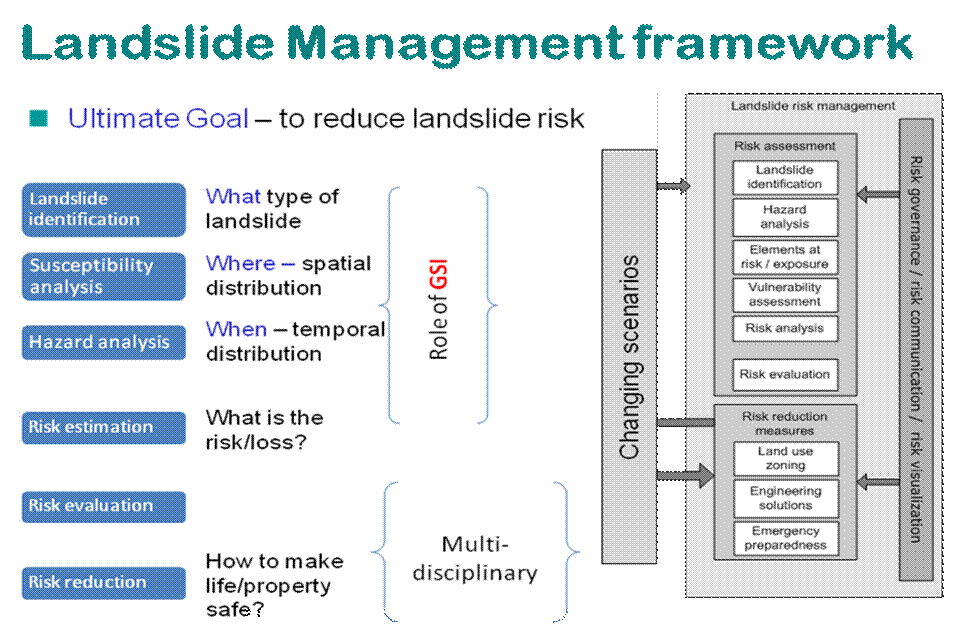National Landslide Susceptibility Mapping Programme
National Landslide Susceptibility Mapping Programme
Under the National Landslide Susceptibility Mapping (NLSM) Programme, launched in the year 2014-15, the Geological Survey of India (GSI), Ministry of Mines takes up landslide susceptibility mapping of landslide prone areas in the country.
What is a landslide?
- Landslide is a physical phenomenon when a part of rock, and/or debris/ soil fall due to the action of gravity.
- It is caused by a set of terrain-specific geofactors (e.g., slope, lithology, rock structure, land use/ cover, geomorphology etc.) and in general is triggered by heavy rainfall or earthquake tremors.
- In Indian terrain, landslide events are mostly triggered by monsoonal rainfall but examples of earthquake-triggered landslide is also not uncommon in India (e.g., Uttarkashi Earthquake, Chamoli Earthquake, Sikkim Earthquake etc)
Landslide Hazard
Protection of life and properties from landslide disaster is indispensable in creating a safe environment for the society. The national imperative towards safety due to landslide initiation is increasing in view of the higher rate of human settlement in the mountain slope across the country.
Landslides are significant amongst those hazards that can be disastrous to human life and property. It is estimated that economic loss due to landslides may reach between 1-2% of the gross national product in many developing countries. Evaluating and mitigating the landslide hazard and risk is a major challenge for the technocrats and decision makers in the developing world as 80% of the reported fatalities due to landslide is within the developing countries.
In India, about 0.42 million sq. km or 12.6% of land area, excluding snow covered area, is prone to landslide hazard. Out of this, 0.18 million sq. km falls in North East Himalaya, including Darjeeling and Sikkim Himalaya; 0.14 million sq. km falls in North West Himalaya (Uttarakhand, Himachal Pradesh and Jammu & Kashmir); 0.09 million sq. km in Western Ghats and Konkan hills (Tamil Nadu, Kerala, Karnataka, Goa and Maharashtra) and 0.01 million sq. km in Eastern Ghats of Aruku area in Andhra Pradesh. The landslide-prone Himalayan terrain falls in the maximum earthquake-prone zones (Zone-IV and V; BIS 2002) where earthquakes of Modified Mercalli intensity VIII to IX can occur, and thus, are also prone to earthquake-triggered landslides. The most recent example is the aftermath of 18 September 2011 Sikkim Earthquake in the Sikkim-Darjeeling Himalayas.
Vision and Strategy (2020-2030) on landslide hazard management
During August 2020, the Ministry of Mines (MoM) has approved the following vision and strategy plans for GSI to carry out landslide hazard studies in India for the next 10 years (2020-2030).
For more information click here.

Activities taken up
Under the National Landslide Susceptibility Mapping (NLSM) Programme, the Geological Survey of India (GSI), Ministry of Mines has completed landslide susceptibility mapping of 4.3 lakh sq. km. of landslide prone areas in the country, including approximately 42,093 sq. km. in Himachal Pradesh. For providing suitable remedial measure for landslides, unstable slopes, etc., detailed site-specific landslide investigations are taken up regularly by GSI based on requests from stakeholders concerned.
Landslide Atlas of India
This Atlas provides the details of landslide present in Landslide provinces of India including damage assessment of specific landslide locations. Geospatial landslide inventory database consisting of ~80,000 landslides in India mapped by NRSC/ISRO under its DMS programme during the 1998-2022 period is reported here. The database covers landslide vulnerable regions in 17 states and 02 UTs of India in the Himalayas and Western Ghats. The database includes three types of landslide inventory - seasonal, event-based and route-wise for the 1998-2022 period.
Seasonal inventory contains pan-India landslide database corresponding to the 2014 and 2017 rainy season in India. Event-based inventory contains details of some of the major triggering events such as Kedarnath and Kerala disasters, and Sikkim earthquake as well as few large valley blocking landslides. Routewise inventory contains details of landslides along selected routes of tourist and pilgrimage importance.Satellite data of high to very high resolution such as IRS-1D PAN+LISS-III, Resourcesat-1, 2 and 2A LISS-IV Mx, Cartosat-1 and 2S, data from International satellites (Sentinel-1&2, Pleiades and WorldView) and Aerial images were used in the mapping of landslides. Some of the mapped landslides were validated in the field using mobile App and news reports. The database were used to rank 147 districts in 17 states and 02 UTs of India for their exposure to landslides in terms of key socio-economic parameters. Lastly advanced techniques in landslide detection, modeling and prediction are also explained.
Details of Landslide Atlas of India
Source : GSI
Last Modified : 8/12/2024
This topic covers the Information related to Lands...
Provides information about Landslide Atlas of Indi...
Provides information about Climate Hazard & Vulner...
